Anyone who has flown a Beechcraft will have come away impressed with the lines quality and, especially, the handling qualities. All the way down to the lowly Musketeer, Beech just took pains to get the airplanes handling qualities a cut above everything else, and that applies in spades to the Baron series. Even so, every aircraft company has to make compromises. In the 55 Baron, for instance, what many find to be pleasant handling characteristics can prove to be a handful in poor weather, or when the air turns green with turbulence. Photo courtesy Eliot Ross And nothing comes for free. No one mistake the Barons for being cheap to own or operate, although thanks to a perennially soft market for twins, theyre no longer ruinously expensive to buy. In fact, there are some real bargains out there on 55s. In the current market-the summer of 2011-55 Barons represent good buys, as we’ll as good investments for pilots who already own them. While the prices of other light twins have tanked due to a sour economy and high gas prices, Barons have declined a little less. But there’s enough softness in the market for the canny buyer to negotiate a deal.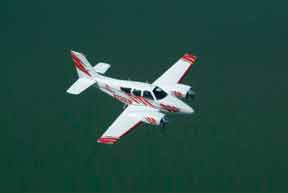
Although Beech isn’t quite the master of the parts-bin model evolution that Piper is, the Baron has nonetheless been through some changes. Like the Bonanza, it comes in two sizes, long- (58) and short-cabin (55). There are several sub-types: The 58 could be had for a time with turbocharged engines and, if desired, pressurization. There arent many P-Barons flying around and today, only the long-body 58 remains in production. (If you want one, plan on an invoice we’ll north of $1.3 million, complete with Garmin G1000 glass.)
The Model 55 was Beechs first Baron. It was introduced in 1961 as a replacement for the Model 95 Travel Air, which was a bit long in the tooth to meet competition from Cessnas 310 and Pipers Aztec. Like the Travel Air, the 55 comprised a Bonanza fuselage fitted with a conventional tail, not the V-tail. In place of the Travel Airs somewhat anemic 180-HP Lycomings, the original Baron had 260-HP Continental IO-470L engines.
After building 190 Barons that first year, Beech came out with the A55, which has a 10-inch longer fuselage and could be ordered with a second fold-down rear seat, bringing potential seating capacity to six (more on that later).
A total of 309 A55s were built in 1962 and 1963. The airplanes nose was then extended seven inches for more baggage and avionics equipment, and gross weight was bumped from 4880 to 5000 pounds.
The airplane was redesignated B55. This version remained in production the longest, until 1983, when all 55s were dropped from the line, along with the 58TC and V-tail Bonanza. Browsing the for-sale ads, expect to see more B55s than any other model because there are simply more of them.
Beech built 1954 of the “long-nose” B55s from 1964 through 1982, not including about 70 T-42A versions for the U.S. Army. Among a number of minor refinements during this time was an increase in gross weight to 5100 pounds, starting with S/N TC-955 in mid-1965. Earlier B55s were eligible for the higher gross through a Beech STC kit.
The big-engine version arrived two years after the B55. The C55 Baron appeared in 1966 with a 12-inch
longer fuselage and 285-HP Continental IO-520C engines.
The “little Baron with the big engines” also was certified with a gross weight of 5300 pounds. The airplane was redesignated the D55 in 1968 and the E55 in 1970. It, too, was dropped from production in 1983, after 1201 were built, 451 Cs, 316 Ds and 434 Es.
Big-engine 55 Barons are easily identified by the air scoops atop the cowlings. The difference in length is less obvious, but it shows up when it comes time to load the airplane: The nose baggage compartment is larger, as is the cabin.
Other differences included the level of standard equipment, and the availability of a 166-gallon fuel system on the big-engine version.
Backwards SwitchesDesigning an airplane is one decision after another followed by one compromise after another. You have to put switches and controls somewhere and Beech decided to put the flap switch on the left, and the gear on the right. There’s nothing at all wrong with that arrangement. But as it happened, everybody else in the industry decided to do just the opposite.
The result was (and is) predictable: A new Baron pilot reaches for the flap switch on rollout and retracts the gear instead. The record shows a long string of gear goofs over the years and although some insist that the switch location has nothing to do with this, other models don’t seem to suffer the same kind of incidents.
The picture is further confused by the fact that in response to customer pressure and its long history of gear-retraction accidents, Beech changed the controls around in later years so they matched the rest of the industry. (This only showed up in later versions of the 58 Baron. The 55 was out of production by the time the change was made.)
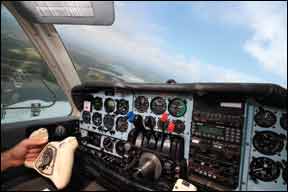
The “backwards” switches arent really a bad design, its just that a pilot has to remain aware of them. Many Baron pilots make a particular point of touching nothing until theyre clear of the runway and stopped, so that they can devote their full attention to the controls.
And its not just the gear and flap switches. Beechs throttle quadrant is different, too. Instead of the more usual throttle-prop-mixture, Beech put the throttles in the middle. But the power levers are taller, so they don’t demand the kind of care you need with the gear switch.
While there have been some fuel mismanagement accidents, the Barons system is simpler than some others. Early models can draw fuel into the engines from the main tanks-37 usable gallons, each side-or the auxiliaries, each with 31 gallons. The fuel system was simplified in 1974 with interconnected tanks and three-position (on, off, crossfeed) selectors. Also that year, extra aux tanks became available for the E55 model, boosting max fuel capacity to 166 gallons.
Cabin, Cockpit, PayloadBeech cabins are notably plush and comfortable, and the 55s-even the early ones-are par for the luxe course. The tapered fuselage, however, can cramp normal-sized adults banished to the rear seats, although it does provide a couple of big windows to ease their exile. Since the rear seats can be gained only by clambering over the middle seats or through the baggage hatch, theyre of little use. Many pilots get rid of them, using the space for baggage.
The front seat of a 55 Baron has to qualify as one of the worlds greatest places to be, with comfort enhanced by a retractable center armrest, adjustable rudder pedals, lots of headroom and good visibility over the nose and out the side windows. Beech was less successful at the finer points of panel design. The massive tube-like structure carrying the yokes obscures instruments on the lower portion of the panel and hides breakers and switches. Also, the seats have limited forward and aft travel.
As twins go, the 55 Baron has decent if not exceptional payload. A typically equipped 260-HP Baron can carry about 1800 pounds of people, bags and fuel; a 285-HP model, about 1950 pounds. There is no zero-fuel-weight restriction, but care is needed to avoid busting the aft CG when the rear seats or aft baggage compartment is used, a typical Beech weak spot.
Balancing the load is facilitated by a nose compartment that can hold up to 300 pounds (270 pounds in early models with gross weights below 5100 pounds). With the fifth and sixth seats removed, 400 pounds can be loaded into this space. Many Barons also have an extended aft baggage compartment approved for up to 120 pounds.
True airspeed of a small-engined Baron cruising at 75 percent power is about 190 knots on 27 gallons of fuel per hour. Thats faster than the naturally aspirated Aztec and Cessna 310, but a good bit off the Aerostars pace. The big-engined Baron is about five knots faster and five GPH thirstier than its stablemate.
Takeoff and landing performance is average. A B55, for instance, can take off or land over a 50-foot obstacle within 2160 feet. The E55 needs only about 2050 feet to clear the obstacle on takeoff but a bit more than 2200 feet to get back over it on landing.
Short-field technique can cut these figures roughly in half, but its hairy, involving lift-off below Vmc, for example. Two-engine climb rates of 1630 to 1700 FPM for the small-engined Barons, and 1670 to 1680 FPM for the more powerful models, outpace the Aztec by a wide margin but lag behind the Aerostar and 310.
The B55s single-engine climb rate is a paltry 318 FPM-again, better only than the Aztec. At 388 FPM, the E55s single-engine performance is about par with the 310 and Aerostar. None of these are exceptional single-engine performers, so the wise pilot will keep them as light as possible.
Range, of course, depends on fuel and that varies a bit in the 55 Barons. Depending on year and model, standard tankage was 100 to 112 gallons but optional tanks of 142 or 166 gallons were also available. The 56TC Baron could be fitted with as much as a whopping 204 gallons of gas.
With 112 gallons aboard, the 55 has acceptable but not exceptional endurance and range.
Figure on 26 gallons an hour at 185 knots in the mid altitudes and three- and four-hour legs are easily doable. Without larger tanks, four-plus hours chews into the reserves. The Baron is not a 1000-mile airplane, but itll knock off 600 miles without breaking a sweat.
The 55 Baron is proof that a light twin doesnt have to handle like a truck. Responsive and well-harmonized, the airplanes controls are one of its biggest selling points. As one owner put it, “Once youve flown an E55, everything else feels like a tin can.” As mentioned earlier, however, hand-flying may be delightful in nice
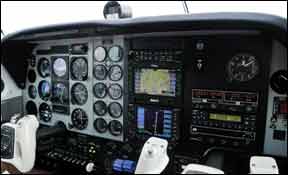
weather, but when it gets bumpy, an autopilot comes in handy.
There are trim controls for ele-vator, rudder and ailerons. Early models have relatively low gear- and flap-extension speeds (143 and 113 knots, respectively). Gear speed was raised to 152 knots, beginning with airplanes built in 1969. The B55 came with approval to lower flaps 15 degrees at 153 knots, and full-flap speed was raised to 122 knots, beginning with TC-955 in 1965.
Maintenance, ModsOwners of all Beech models consistently complain about one thing: The high cost of Beech parts, especially control surfaces in need of replacement due to hangar rash or corrosion. Fortunately, the 55s arent considered maintenance hogs and owners say replacement parts arent needed often.
Much maintenance relates to the engines. The O-470s are among the most robust and reliable engines in the Continental line and although the O-520s are nearly as good, they seem to suffer premature cylinder wear. Some owners complained of low compression on Continental cylinders after 500 or fewer hours.
Owners say annuals range from $2000 to as much as $6000, but we think the wise owner will budget at least $10,000 a year to cover both the annual and ongoing maintenance. As an hourly maintenance cost, one owner told us a good guideline is to double the fuel cost. With avgas running about $4.50 a gallon, that works out to about $230 per flight hour. Fly 150 hours a year and you’ll spend about $35,000 to include engine reserves.
The IO-470L is considered a bulletproof engine, although a few owners, as we’ll as several Service Difficulty Reports, mentioned occasional cylinder problems. The IO-520s reputation is not so good; operators have been beset by cracking crankcases. Continentals switch to so-called “heavy” cases in the late 1970s helped somewhat, but case cracks and broken camshafts have appeared frequently in the SDRs.
Among the notable Airworthiness Directives are: 87-18-06 Rev. 1, requiring replacement of recline-actuator handles on copilot and center passenger seats to prevent inadvertent unlocking; 84-26-02, replacement of paper air filters; and 84-09-01, requiring various inspections and modifications to ensure that the emergency window will open. Prospective buyers should also ensure that 91-15-20 (repair or reinforce cracked engine mounts) has been complied with.
There are three ADs on the props: 97-18-2 (repetitive inspection, A55 and B55 Hartzell props); 95-24-5, (repetitive inspection, E55 McCauley props); and 91-15-4, on the A55. AD 89-5-2 deals with cracking elevator components, with possible replacement of the elevator.
Owners of Beech 55, 56TC, 58 and 95 Barons should look for cracks in the wing forward spar carry-through. The cracking, according to Airworthiness Directive 90-8-14, could lead to “loss of the airplane.”
Beech first apprised owners through a mandatory service bulletin. The bulletin-No. 2269-was originally issued in August of 1989. In March 1990, Beech revised the bulletin, saying “Recent engineering investigation has shown that increased allowable crack lengths as described in this service bulletin will not compromise the integrity of the forward spar carry-through structure.”
The AD specifies that the carry-through must be inspected at 1500 hours total airframe time and repeated every 500 hours if no cracks are found. To get at the carry-through, the mechanic must remove the front seats and the carry-through cover on the floor. From there, its a standard crack inspection. The carry-through and webs are cleaned, then checked using visible dye-penetrant. If no cracks are visible, he can button it up and come back in 500 hours. But if cracks are visible, its time to get out the rulers. The cracks must be measured and, depending on where they are and how long they are, repaired. Beech sells a kit to do any required repair work.
The other area of concern is the spar web face, in the area of the huck fasteners. Here, cracks are limited to one inch length. Only one crack is allowed per side, and Beech specifies that it cant be stop drilled. Instead, the mechanic must look at it again in 200 hours to see if the crack has grown.
If it has grown, or if it was more than an inch long to begin with, another Beech kit is needed for the proper repair. The repair must be made within the next 25 hours, or immediately if it is between two fasteners and extends more than a half inch beyond the fasteners.
Beech figures one man should be able to complete the inspection in four hours, provided the airplane is already apart for an annual or similar inspection. Like EPA mileage estimates, your labor charge may vary.
If cracks are found, there’s the added cost of stop drilling, plus the price of the kits if the cracks need repair. The kits cost several hundred dollars each. Installation time depends on the shops sheet metal proficiency. The average shop should be able to install one kit in about 55 to 60 hours.
Many mods are available for the Baron, including the usual engine upgrades from Beryl dShannon and Colemill. General Aviation Modifications makes GAMIjectors for the Baron line. One mod in particular deserves mention, since it gives such a dramatic improvement in performance: vortex generators.
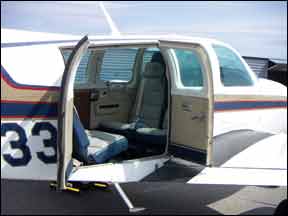
VGs are available from a couple of different manufacturers. We tested V/G Systems product for an early issue of The Aviation Consumer. Bottom line: They work as advertised. Kits are available from Beryl DShannon and Micro AeroDynamics, Inc. of Anacortes, Washington.
Baron owners don’t have an association of their own, but the Wichita-based American Bonanza Society supports the Baron along with the Bonanza. The ABS publishes an informative newsletter and conducts service and proficiency clinics at about a dozen locations each year. American Bonanza Society, Mid-Continent Airport, P.O. Box 12888, Wichita, Kansas 67277, phone 316-945-1700 or http://www.bonanza.org/.
Owner CommentsI am a 3500-hour private pilot and have owned my Baron for the past 11 years. I decided to purchase a twin upon review of my flight missions, which included routine night flights, long distances over water, and carrying two to four passengers. I frequently fly from the Washington, D.C., area down to south Florida and find the Baron is we’ll suited in both speed and comfort for long trips.
The Baron can handle most weather, with its onboard radar and deicing equipment. Even though it is somewhat shorter than its big brother (58 series), it is a rock solid IFR platform. But it does have a slight tendency to Dutch roll in heavy turbulence. Its light on the controls, but gives you the feel of a heavier aircraft.
I do not run my engines lean of peak. I flight plan for 29 GPH, which gives me a true airspeed of 180 knots at 23 square, which is about 70 percent power. The Baron will climb from sea level at a steady 1000 FPM to about 7000 feet. Single-engine climb is an honest 230 FPM depending on weight and conditions. I have seen in excess of 300 FPM.
My absolute minimum for runway length is 2800 feet. But on a hot day, or with high density altitude, you would be foolish to try to take off in that distance. I have VGs on my Baron and highly recommend them. VGs places Vmc below stall in a clean configuration, and makes short-field operations more manageable.
I have the 142-gallon tanks, which yields 4.5 hours of flying time ’till dry. This is over 700 nautical miles. The Barons max gross weight is 5100 pounds, which gives you a payload of 1400 pounds. Subtract full fuel and you are left with 548 pounds for the cabin.
I keep close records of all my annual costs. My maintenance costs have been remarkably predictable. Expect to budget $55 per hour. My annuals usually are $2500 to $3500. Insurance, in a good year is $3600; in a bad year $4900.(Not from accidents, but market cycles.) I strongly recommend to keep your airplane in a hangar, which costs me $2700/year in Western Maryland. I do not reserve for engine overhauls, but having put new engines on it once, I can say you will spend about $60,000 on factory overhauls. The Continental IO-470s are bulletproof. While I would like the performance of turbos, I don’t miss the maintenance. I fly my Baron about 130 hours a year. It aint cheap, but the convenience, safety, and utility are unparalleled.
If you are looking for the safety of a twin to haul your family and friends around the country, look no further than the high-quality Beechcraft Baron. It is at the top of the line in its class and is a fraction of the cost of larger turbocharged twins, or dare I say any turbine aircraft.
Tom Malone
via email
Thirty-five years ago, I was flying my turbo Twin Comanche at night from Dallas to Washington, D.C., when I got into serious weather at 20,000 feet. Upon landing, I decided to upgrade to a twin with radar and deicing capability. After a lengthy study of different models, I bought a Baron 55 and never looked back.
For the next 15 years, I flew regularly from Gaithersburg, Maryland, to my Pittsburgh office and never cancelled a trip because of mechanical difficulties or weather. On balance, my Baron proved to be reliable and easy to fly. I would also argue that once cleaned up and climbing to my assigned altitude, I found it was easier to fly IFR than any single-engine aircraft. With onboard radar and deicing, I regularly flew over the western U.S. when based in Denver.
Several issues are of importance: First, parts from the factory can be prohibitively expensive. When I had to replace a flap motor, Beechcraft wanted $1200. I found a vendor in Wichita who rebuilt these motors for Beechcraft and I was able to get a yellow-tagged motor for $280.
Beechcraft builds a quality product and while parts are expensive, I found that the airframe and systems were more reliable than any other aircraft I owned. My turbo Twin Comanche, in contrast, was a maintenance hog. It seemed to automatically turn towards the closest maintenance shop on its own after landing at a strange airport.
Also, my Baron carried a substan-tial load if you didnt fill up the long-range tanks. I recalled an incident concerning a friend whose son attended a prep school in Maine. The son was engaged in basketball tournaments held in Augusta, Maine, and in Hartford, Connecticut, both on the same day. I shuttled the five first-team players between the tournaments without too much difficulty. (Coincidentally, the team won both championships.)
The Baron performs reasonably we’ll on one engine. I had my right engine overhauled at a shop in Hagerstown, Maryland, and was told they had thoroughly checked out the engine and had test flown the airplane for nearly two hours. As it happened, the airplane had never left the ground and I unwittingly became a test pilot. The engine blew up on takeoff at 500 feet and I feathered the engine and returned safely to the airport. As in any twin, one must assume that with every takeoff, an engine will fail. If you fly the numbers and comply within the operation limitations, you will not get into any trouble.
The Baron is a straightforward aircraft having no measurable faults. With fuel prices on the East Coast approaching $6 a gallon and higher, all twins are expensive to operate. Of note, Beechcraft marketing once demonstrated the fuel efficiency of the B-55 against a turbo Cessna 210. In a three-leg closed traverse, both aircraft flew at the same altitude and identical legs each within six minutes of each other. After the 350-mile trip, the Baron made the trip six minutes faster using three fewer gallons of fuel. The Barons efficiency is at power settings between 55 and 65 percent. The Aztec and Cessna 310 have comparable speeds at 75 percent power settings; at lower power, they slow down much more rapidly than the Baron. I regularly flew at 170 knots at 22 GPH, which is close to the performance of single-engine aircraft.
With nearly 2000 flying hours in the Baron, I found the aircraft to be very reliable. I would choose another Baron should I ever consider purchasing another twin. After selling my engineering practice, I reluctantly sold my Baron and I am now flying a Mooney, yet another fuel-efficient transportation vehicle.
James J. Davis
Leonardtown, Maryland
I own a 1975 95B-55 with the Colemill upgrade and an updated panel plus an S-Tec 55X autopilot connected to a WAAS receiver. I chose this model as it is probably the safest piston aircraft available. The centerline thrust on the B55 models is substantially closer to the fuselage than almost any other production twin and the loss of an engine at takeoff is little more than a few seconds of opposing rudder while the yaw is manually trimmed out to neutral. After that, especially with the IO-550s and three-blade props, it is just like flying a single, excepting the caution required in turns.
Most of my flights in excess of one hour are flown in the teens and lean of peak at 195-plus TAS. I have flown to FL210 and reached it still showing 400 FPM at 120 knots indicated at 400 pounds shy of gross. The POH rates max usable gross with full fuel (136 gallons) at 650 pounds on the original engines. With the IO-550s, the performance difference between max gross and single-pilot load only shows up as a slightly longer takeoff roll and a marginally reduced speed at 1200 FPM climb to
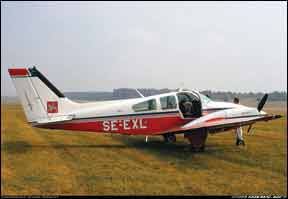
5000 feet. Once at cruise, the difference is approximately four knots.
This is a true four-passenger aircraft. The engines run very cool and it is rare to see CHTs above 340 degrees on even the hottest day. I have alcohol props and windshield and have used both occasionally when flying through thin tops where diversion is difficult. But with that much power, climbing is truly one possible out among others.
Landings require attention to flying by the numbers as the aircraft will rapidly accelerate once the nose is pointed down. Pulling back to 18 inches MAP/2100 RPM prior to descent is a must if you want to stay out of the yellow arc at the IAF.
Takeoff at max gross in my plane at sea level is just under 2000 feet and landing in the net configuration (less 32 gallons) can be as little as 1000 feet for the experienced short-field pilot.
The airframe is built like a truck and the gear is quite rugged. The airframe is very solid in turbulence. Maintenance has been minimal and my biggest expense has been the continual upgrade in avionics, all of which are enhancements to safety.
I have also added VGs, which seem to have had no effect on cruise speed, but are impressive in the added stability at low speed (short field) landings. Xenon nav lights and beacon, a thick front windscreen, gap seals and Eagle drains have been added as well.
One of the very few downsides is the lack of oil filters, utilizing screens instead. This necessitates changing oil at 30 hours versus 40 hours and cost $400-plus. Fortunately, modern oils show little propensity for breakdown at that point, with corrosion being a bigger threat to engine life.
Upon landing, I immediately open the oil filler caps and allow the vapor to escape for at least 10 minutes, which keeps corrosion to a minimum. Annuals run $4000 including the usual extras like trim adjustment, vacuum pumps and wear-related items. The 2000-hour replacement list will run close to $9000. My average fuel burn is 32 GPH and 36 GPH at lower altitude flights.
I insure at market value, which right now is around $150,000 for my setup and pay $4000 annually. Belonging to the American Bonanza Society is a must, as the tech support and recurrent training is the best of any type organization that I am aware of, and the regional groups-Pacific Bonanza Society, Rocky Mountain Bonanza Society-have frequent fly-ins which are very we’ll attended and are a great opportunity for valued hangar-flying exchanges.
I have flown this bird over 800 hours in the past five years in all kinds of conditions and have the greatest respect for the capabilities of this wonderfully designed and constructed aircraft.
Ronald Hays
Santa Barbara, California


